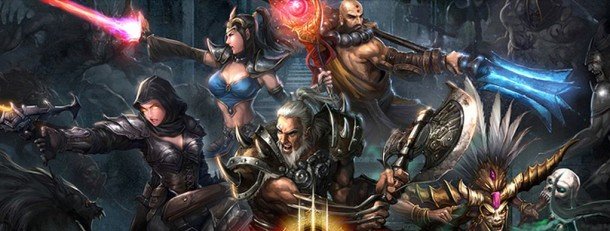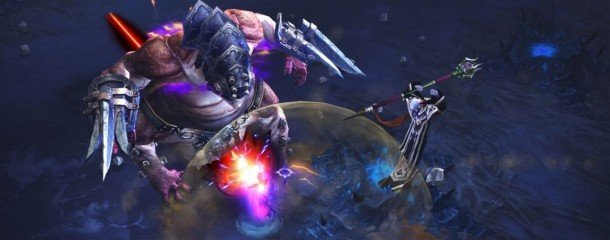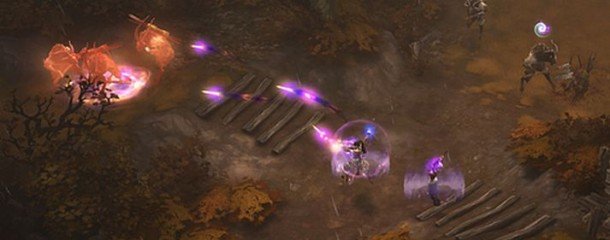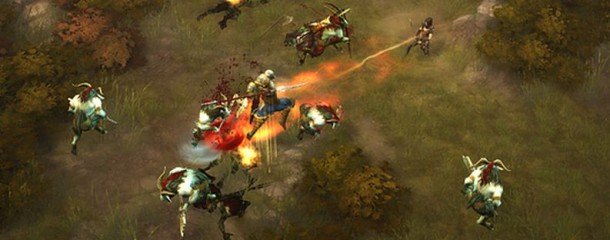Editorial: How Diablo 3's endgame has failed


It's an action RPG, of course. One burdened with the inconveniences of an MMO and blessed with few of the advantages. It requires a permanent internet connection to play, public matchmaking and an auction house that lets the whole world share their wares. In spite of all that, there's no wider society to Diablo 3. Each session is an insular carnival of violence. There are no guilds. There is no sense of community beyond the cold "buyout" button on the auction house.
I'm okay with that. I don't need that social hit from Diablo 3. At heart it's a very excellent game about hitting things in strange and spectacular ways. Sometimes with a few friends. For sixty levels and three difficulty tiers it delivered, but suddenly its character changed entirely. After a rush of new skills, more powerful enemies and ever more devious randomly generated boss mobs I hit a wall. Progress became difficult and tedious and those long-promised legendary weapons moved further and further out of reach. I felt like Charlie Brown taking a swipe at Lucy's football , only in this strip she didn't just pick the ball up and laugh in my face, she moved it to the top of a mountain and shouted "come and get it!"
And like a fool, I tried.

I wrote in the last issue of PC Gamer UK about my battle with Diablo 3's repair costs, which were hiked massively after launch. Chris and I broke our equipment in the middle of a co-op session on Inferno and didn't have the cash to repair it. We could run the final level on a lower difficulty to grind gold, a boring prospect given our characters' strength, or buy gold with pounds on the real money auction house. It's the sort of choice I'd expect to face in a bad free to play game, but here it was waiting at the end of Diablo.
Chris has barely played since then. I took the Charlie Brown option. I put ten quid into the real money auction house and bought 100,000 gold (about three repairs at Inferno level) for 27p.
27 pennies. Hardly devastating, I know. I didn't weep over the Mars Bar I could've bought with that money, and it got me back into the game. The feeling you get when you put down money for a microtransaction is important, however. It shouldn't make you feel as though you've been duped by an arbitrary number system. It shouldn't leave you on your back on the football field, staring up at a ball that, you're starting to suspect, is completely unreachable.
The auction house is all-consuming at high levels in Diablo 3. Drop rates have been modified upwards extensively since launch and the Paragon levels added in a recent patch lets players increase drop rates by 3% with every ding. Nonetheless, I can't remember the last time a usable item dropped for my level 60 Barbarian. The odds that I'll discover anything that I can directly equip seem absurdly small. At Inferno level, gear is everything. You're as tough as the armour you're wearing. To get precisely what you'll need, the auction house is the only viable option.
The biggest gaming news, reviews and hardware deals
Keep up to date with the most important stories and the best deals, as picked by the PC Gamer team.

Diablo 3 has become a game about gold. Its endgame, with the auction house at its heart, is about slow, incremental progression, cash runs and repeated boss raids. It relies on grind-heavy objectives that feel very different to the rush of new skills I enjoyed on the journey to level 60.
An action RPG has a natural shelf life. Some will get everything they want from a single playthrough, others when they hit sixty, and others when they have the finest loot and have beaten the toughest enemies. For the latter group, the endgame feels like a Skinner box tailored for those with a completionist spirit, designed to postpone that point of disengagement indefinitely.
Keeping players playing is an increasingly important concern for publishers. The time and finance needed to produce a big budget release demands a bigger return than good week-one sales. We're seeing more systems designed to grow a game's lifespan and, with the help of microtransactions, its long term moneymaking potential.
Keeping players engaged isn't a bad thing in itself, of course, but it's interesting to keep track of the increasingly diverse mechanisms that studios are using to keep us hooked. The Diablo 3 auction house/endgame package is a troublesome case, but Mass Effect 3's multiplayer mode does it right. It exists in its own bubble, with only vague narrative ties to the single player campaign. It's updated regularly with new maps, weapons and character classes, and its box lottery system makes money from players without dividing them between map packs and expansions.
Blizzard take a cut of transactions completed on the real money auction house, of course, but it's more than a money grabbing exercise. Publishers are increasingly keen to bind their games into unifying systems like Battle.net, in which items and money earned in one game can be spent on another. Money earned selling items in Diablo 3's auction house can be used to buy World of Warcraft game time with a few clicks via the Battle.net balance system. World of Tanks, World of Warplanes and World of Warships will share a single currency. Rockstar have relaunched Social Club, Nadeo have Maniaplanet, and Medal of Honor: Warfighter has merged with Battlefield 3 on EA's Battlelog system recently.

More than ever, Publishers want us investing time and money into contained ecosystems that bounce us from one game in their catalogue to another. These efforts are easily ignored, for the most part, but in Diablo 3's case the system designed to extend the game and make extra money from players changes Diablo 3's very nature. It stops being a game about smacking demons, and turns into a game about shopping.
In the run up to Diablo 3's launch, Blizzard painstakingly detailed their thinking behind the late alterations they were making to Diablo 3, providing a fascinating insight into the design process. They tore up many of the accepted action RPG elements that Diablo invented. Teleportation scrolls were deemed extraneous, so they went. Unnecessary stats were thrown out, skills were altered or dropped entirely to ensure that every ability had a purpose. NPCs were culled until only the Blacksmith and the Jeweller remained. The end result was finely pruned, impactful and addictive, supported by a levelling system that favoured experimentation over the incremental stat progression and sparse ability options offered by traditional skill tree set-ups.
And yet, this carefully honed and, in many ways, brilliant action RPG finds itself swamped by a bloated final quarter. The climactic rewards of an action RPG – the best loot and the toughest bosses - are hidden behind layers and layers of plodding gold-gathering, Paragon levelling and bargain hunting. The systems designed to fuel ongoing auction house trade and develop a cross-game economy have stretched Diablo 3's longevity beyond its natural breaking point. Blizzard continue to release major updates that may yet turn things around, but for now it looks as though quest to keep players playing forever has backfired.
We haven't seen the last of the auction house. I think we'll see similar ideas popping up in future releases. A full price game supported by ongoing microtransactions will seem increasingly ordinary as time passes and major studios start looking harder at the techniques free to play games have used to make a fortune over the last few years. Guild Wars 2, Mass Effect 3, Assassin's Creed 3 and Diablo 3 are a few of this year's big examples. What will be next?
Part of the UK team, Tom was with PC Gamer at the very beginning of the website's launch—first as a news writer, and then as online editor until his departure in 2020. His specialties are strategy games, action RPGs, hack ‘n slash games, digital card games… basically anything that he can fit on a hard drive. His final boss form is Deckard Cain.


